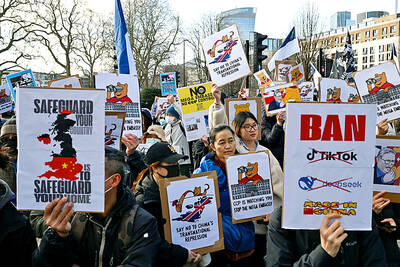At US$196 billion, the amount of money US taxpayers spent during the lifetime of the space shuttle program seems astronomical.
However, the entire US federal government spends that much in just three weeks. In big bucks Washington, even US$196 billion is relative.
The space shuttle is a bargain compared to wars, healthcare, tax cuts and budget deficits. However, compared with the Apollo program and even some of the banking, auto and insurance industry bailouts, the price for going into orbit seems a tad high.
For that US$196 billion, the US got five space shuttles and what will be 135 flights, when the last launch, scheduled for Friday, is included. That figure includes design and construction spending dating back 40 years to when the program was first conceived. When all of that is included, the cost per launch is about US$1.5 billion. If you exclude those early expenses and costs for upgrades and so forth, the average operating cost of a shuttle flight is US$847 million.
So even at the cheaper calculation, each shuttle launch on average costs more than the US$800 million that the US Food and Drug Administration spends in an entire year on food safety.
The overall US$196 billion is also slightly more than the US$182 billion bailout of failed insurance giant AIG and much more than the US$45 billion apiece that went to Bank of America and Citigroup to shore them up in 2008 when the nation’s financial system was teetering on the brink. It dwarfs the US$49.5 billion rescue of General Motors and the US$12.5 billion bailout of Chrysler.
Compared with other big engineering concepts, even when adjusted for inflation, the space shuttle program might have gotten less bang for more bucks. The Apollo program to the moon cost US$156 billion, the Manhattan project that created the first nuclear bomb cost about US$29 billion and digging the Panama Canal cost US$8 billion, the Smithsonian Institution said. The US got the moon, the bomb and the canal for a total of US$193 billion — US$3 billion less than the space shuttle.
However, compared with other federal spending, the space shuttle barely gets off the ground in terms of big money.
Last year, the federal Medicare healthcare program for the elderly spent US$196 billion in about five months. The 40-year lifetime price tag of the space shuttle program is less than one-sixth the government’s US$1.2 trillion estimate for the Iraq and Afghanistan wars so far. The current federal budget deficit is heading for about US$1.4 trillion — seven times the shuttle program’s overall cost. Experts put the cost to federal coffers of the 2001 tax cut at somewhere between US$1 trillion and US$2 trillion.
For a more down-to-Earth comparison, the space shuttle doesn’t quite measure up to the family car. It costs about US$0.37 per kilometer to drive a car on average, according to AAA. The cost of the 861 million kilometers flown by the space shuttle is about US$224 per kilometer.

‘SHORTSIGHTED’: Using aid as leverage is punitive, would not be regarded well among Pacific Island nations and would further open the door for China, an academic said New Zealand has suspended millions of dollars in budget funding to the Cook Islands, it said yesterday, as the relationship between the two constitutionally linked countries continues to deteriorate amid the island group’s deepening ties with China. A spokesperson for New Zealand Minister of Foreign Affairs Winston Peters said in a statement that New Zealand early this month decided to suspend payment of NZ$18.2 million (US$11 million) in core sector support funding for this year and next year as it “relies on a high trust bilateral relationship.” New Zealand and Australia have become increasingly cautious about China’s growing presence in the Pacific

Indonesia’s Mount Lewotobi Laki-Laki yesterday erupted again with giant ash and smoke plumes after forcing evacuations of villages and flight cancelations, including to and from the resort island of Bali. Several eruptions sent ash up to 5km into the sky on Tuesday evening to yesterday afternoon. An eruption on Tuesday afternoon sent thick, gray clouds 10km into the sky that expanded into a mushroom-shaped ash cloud visible as much as 150km kilometers away. The eruption alert was raised on Tuesday to the highest level and the danger zone where people are recommended to leave was expanded to 8km from the crater. Officers also

The team behind the long-awaited Vera Rubin Observatory in Chile yesterday published their first images, revealing breathtaking views of star-forming regions as well as distant galaxies. More than two decades in the making, the giant US-funded telescope sits perched at the summit of Cerro Pachon in central Chile, where dark skies and dry air provide ideal conditions for observing the cosmos. One of the debut images is a composite of 678 exposures taken over just seven hours, capturing the Trifid Nebula and the Lagoon Nebula — both several thousand light-years from Earth — glowing in vivid pinks against orange-red backdrops. The new image

ESPIONAGE: The British government’s decision on the proposed embassy hinges on the security of underground data cables, a former diplomat has said A US intervention over China’s proposed new embassy in London has thrown a potential resolution “up in the air,” campaigners have said, amid concerns over the site’s proximity to a sensitive hub of critical communication cables. The furor over a new “super-embassy” on the edge of London’s financial district was reignited last week when the White House said it was “deeply concerned” over potential Chinese access to “the sensitive communications of one of our closest allies.” The Dutch parliament has also raised concerns about Beijing’s ideal location of Royal Mint Court, on the edge of the City of London, which has so